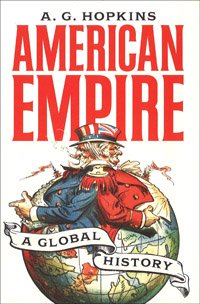
The print version of this article can be downloaded as a PDF file.
A.G. Hopkins is Emeritus Smuts Professor of Commonwealth History at the University of Cambridge. He was elected a Fellow of the British Academy in 1996.
Empire studies are booming. A series of shocks has added impetus to the ‘global turn’ in history and the social sciences. The traumatic events of 9/11 caused commentators and policy-makers in the West to grapple with hostile and largely unknown supra-national forces. The devastating financial crisis of 2008 shook the comfortable assumption that globalisation would deliver benefits rather than costs. The unanticipated appearance of China as a major world power and a prospective new empire renewed the debate over the rise and fall of great states. In reaching beyond national boundaries, historians have reappraised standard approaches to the great empires of the past. As the number of books dealing with imperial history has increased during the last decade, so the number of new topics worth studying has shrunk. Yet important omissions can still be found. The history of the empire of islands ruled by the United States is one seemingly obvious subject that has been overlooked.
The United States is often called an empire, though typically the term is used in a very general sense to refer to its position as a leading world power. The problem with the label is that, after 1945, the United States exercised power in ways that were very different from those that characterised the great European empires during the previous three centuries. The US had bases but it did not integrate territories; its motives were strategic rather than political or economic. During the first half of the 20th century, however, the United States possessed a territorial empire in the Pacific and Caribbean. This was the insular empire, which was acquired after a war with Spain in 1898, disposed of following the Second World War, and is now forgotten. The last substantial book on the subject was published in 1962. Research on individual islands has progressed and is now detailed and of high quality. As yet, however, a sense of the totality is missing, as is an understanding of how it might relate to the huge volume of research on British and French colonial rule.
The insular empire was undoubtedly small, both in relation to the United States’ mainland and to the vast British and French empires. Nevertheless, in 1940 the United States ruled over 13 inhabited overseas territories, which (with Alaska) contained about 19 million people. Ninety-nine per cent of the total lived in the Philippines, Puerto Rico, and Hawaiʽi. (If Cuba, the clearest example of a protectorate, is added, the total rises to about 23 million.) This was a sizeable number of colonial subjects to govern, and foreign citizens to influence. Other small overseas empires, notably those of Germany and Italy, have their place in surveys of Western imperial history; the US empire deserves to make an appearance too. Moreover, size and significance are poorly correlated. The American Empire had sufficient diversity to make it representative of the Western empires as a whole. Like the European empires, the United States had colonies dominated by white settlers (Hawaiʽi), colonies where expatriate-owned plantations were common (in Puerto Rico and the protectorate of Cuba), and colonies where export production remained largely in the hands of local people (the Philippines). Far from being either obscure or uniform, or both, the islands were turnstiles of globalisation joining continents, while their diversity made them microcosms of the much larger British and French empires. Accordingly, the evidence can be applied to one of the central questions of US history: was the United States an ‘exceptional’ nation in its purposes, methods of rule, and outcomes, or were similarities with other Western imperial powers more important than differences?
The insular empire undoubtedly had a number of distinctive features. It consisted of a set of scattered islands which, apart from Hawaiʽi, were inherited from Spain and contained stocks of Spanish settlers and their descendants. The empire’s insular characteristics, however, appear to have had no significant influence on the formulation or implementation of US colonial policy. The Spanish legacy, on the other hand, had an enduring effect on relations between rulers and ruled. No other Western power had inherited the greater part of its empire from another Western power. Nevertheless, though US officials began with the aim of eliminating ‘medieval’ practices inherited from Spain, they soon recognised the need to adapt them to the priorities of the new empire. Consequently, the legacy from Spain facilitates, rather than invalidates, comparisons with other Western empires. The historical record summarised here suggests that similarities rather than differences emerge from the comparison.
At the beginning of the 20th century, imperial enthusiasts, like Theodore Roosevelt and Albert Beveridge, claimed that the United States would reinvigorate the Western ‘civilising mission’. It was then that the United States launched the first of the nation-building and development programmes it was to repeat after 1945. The experiment, which treated the new empire as a laboratory, was one of the earliest attempts to apply what would later be called modernisation theory. Although subsequent politicians and commentators in the United States became wary of using the term ‘empire’ and adopted euphemisms, such as ‘overseas possessions’, instead, the shift in nomenclature did not signify a change in attitudes towards the territories under US rule. It did, however, help to make the empire less visible. It remained present but was unobserved.
The United States and the European empires had a common ideology that validated colonial rule. Racial superiority endowed the white branch of the human race (and especially its Anglo-Saxon, Protestant representatives) the right and duty to spread the ‘civilising mission’ to less fortunate peoples who required, by definition, a long period of paternal tuition. As Washington’s eager new imperialists saw it, American energy, capital and technological wizardry would carry to a successful conclusion the programme that old and increasingly degenerate European powers lacked the vitality to complete. The constitutional basis of US rule was varied and at a times baffling, as it was in the European empires. The United States sported unincorporated states, incorporated states, commonwealths, and protectorates. As in the case of Britain and France, these categories were devised to ensure that the possession of foreign countries could be squared with constitutional theory and practice at home. The management policies derived from assumptions of superiority and claimed legal rights were the same as those found in the European empires. They included a mixture of direct and indirect rule, experiments with policies of assimilation and association, and measures to encourage what was called ‘uplift’ through Western education and the spread of Christian missions. Similarly, the economic basis of US colonial rule rested on revenues derived principally from the export of raw materials (the most important being sugar) from the colonies in exchange for a variety of manufactures (typically consumer goods).
In principle, the presence of these commonalities is consistent with a record of progress that places the United States ahead of the results achieved by Europe’s colonial powers. However, satisfactory estimates of the benefits and costs of colonial rule in the insular empire have yet to be undertaken. The problem is in any case intractable because important variables are unmeasurable. Nevertheless, approximate indications suggest that the performance of the United States fell far short of the aspirations of the founders of the empire and was probably about the same as that of the European empires during the first half of the 20th century.
The ideas were expansive; the commitment was limited. The US Congress quickly lost interest in the possessions it had acclaimed with such enthusiasm in 1898. The new insular empire then became a counter in the political game played between Republicans and Democrats. Without a bipartisan policy towards the empire, the continuity the civilising mission needed was never established. Moreover, Congress had little incentive to give imperial affairs priority over the pressing concerns of domestic voters. It ignored its obligations as much as it could, and refused the funds needed to create a Colonial Office and to finance development plans. Professionally-trained personnel were in short supply; governors were appointed for political reasons, either to be rewarded or exiled; few stayed in the job for more than two or three years. Given that the empire was too small to be regarded as a matter of national importance, crucial aspects of policy were decided not by the needs of the civilising mission, but by battles between competing lobbies, which fought for supremacy in Washington with their own interests in mind. By the 1930s politicians were keen to offload the Philippines and Puerto Rico. Neither territory had achieved the stated goals of viability and democracy; both had become troublesome and costly.
The insular empire was certainly no more popular among its subjects than were the British and French empires. US troops were not greeted as liberators. Fierce resistance in the Philippines lasted for a decade after the United States declared victory in 1902. Hawaiʽi, the ‘island paradise’, experienced massive strikes whenever the sugar industry ran into difficulties, as did Puerto Rico, Spain’s former ‘Enchanted Isle’, while in Cuba cane-burning became a familiar act of last resort. During the troubled 1930s, urban strikes and protests complemented continuing discontent in the rural areas, as they did in the European empires. The assassination of leading officials was contemplated, sometimes attempted, and in at least one case succeeded. In response, the United States cracked down on dissidents with a vigour that equaled the repressive measures adopted in the British and French colonies. The civilising mission had reached the point where it needed secret police aided by networks of spies and informers to keep it on course.
The insular empire came to an end at the same time and for the same reasons as the European empires. The Philippines became independent in 1946; Puerto Rico acquired an ambiguous title, that of a Commonwealth, in 1952; Hawaiʽi was incorporated as a state in 1959; Cuba broke away in the same year – and has never been forgiven. These events did not signal the end of either US interests or the American presence, but they did open a new chapter in a different story. Shortly afterwards, the history of the insular empire was effectively redacted. In 2011, General Stanley McChrystal, reflecting on his experience commanding coalition forces in Afghanistan, observed ruefully that ‘we didn’t know enough … and we had a frighteningly simplistic view of recent history, the last 50 years.’ The ‘lessons of history’, had they been taught, would probably have made much of Greece, Rome, and Britain. A more appropriate syllabus, had it been available, would have focused on the United States’ own experience of colonial rule. The salutary record of the insular empire might have given Washington cause to reflect on what Donald Rumsfeld called ‘known knowns’ before wading into successive quagmires in Asia and the Middle East.

How are we doing? Your feedback is important to help us shape future issues of the British Academy Review.
To provide reader feedback, please visit www.britishacademy.ac.uk/british-academy-review-feedback